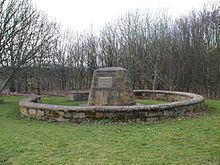Anniversary Of Scottish Victory At The Battle of Rosslyn
On 24 February 1303 a force of 8,000 Scots defeated an English army of 30,000. The English forces were led by Sir John de Segrave who was angered at the failure of his attempts to marry Lady Margaret Ramsay of Dalhousie. She chose instead Sir Henry St. Clair of Rosslyn. With the support of the English King Edward I, John de Segrave launched his attack on Scotland.
Roslin is a village in Midlothian (Scottish Gaelic: Meadhan Lodainn) and near the site of the Battle of Rosslyn. It was one of the most important battles in the First War of Scottish Independence (1296–1328) which was the initial chapter of engagements in a series of warring periods between the forces of England and Scotland after Edward I of England invaded Scotland in 1296.
The Scots became aware of the threat in 1303 when the enemy succeeded in reaching Melrose in the south-east of Scotland close to the English border. John de Segrave sperated his forces into three: one group with the objective of attacking Borthwick Castle, the second to besiege Lady Margaret's home of Dalhousie Castle while the third, led by de Segrave himself, was launched against Rosslyn the home of Sir Henry St. Clair.
The swift reaction of the Scottish was crucial with Prior Abernethy of Mount Lothian, sending monks on horseback to alert important leaders. They succeeded in gathering an army of some 8,000 Scots at Biggar by the afternoon of 23 February 1303. The Scottish encircled the first contingent of the English army on an embankment of the River Esk in the early hours of February 24th. Segrave was among those captured for ransom. Survivors fled into the woods but were ambushed. Some managed to alert the second group of English forces, besieging Dalhousie Castle under the command of Sir Ralph de Confrey.
The English rode to face the Scottish, now positioned in a defensive line across the summit of Langhill. As they charged up the hill, they were attacked by Scottish archers and were driven back across the field towards a ravine where they were killed with many plunging to their death. The success achieved in this second battle by outnumbered Scottish forces gave them little time to recover. They now faced the third English force of 10,000.
Prior Abernathy then rallied the exhausted Scottish. He had arranged for a wood and canvas Saltire to be erected on the Pentland hills where it reflected the evening sun. He pointed to the Saltire telling them it was a sign that God blessed their cause. They held the high ground above the Esk valley at Mountmarle. As the English approached along the valley they were ambushed and routed by the Scots who charged them from above.
After this staggering defeat it is said that as little as 10 per cent of all the English soldiers returned home. The importance of the Battle of Rosslyn should never be overlooked. Against overwhelming odds brave Scottish forces won a great victory although it took many more years of struggle before the decisive victory over the English at Bannockburn in 1314.

- Douglas MacQueen's blog
- Log in to post comments





